Safety and quality in healthcare are not mere talking points but the linchpins of patient trust and clinical success. As medical professionals strive for excellence, integrating evidence-based practices into patient care has become paramount in safeguarding patients’ well-being. Pivotal to this endeavor is the synthesis of rigorous research with practical application—a task undertaken daily in healthcare settings around the globe. In pursuing optimal outcomes, medical practitioners are turning to best practices founded on solid evidence and implementation strategies that bear the weight of scientific scrutiny. Keep reading to explore how these methods transform patient care, making safety a standard, not an afterthought.
Implementing Evidence-Based Practices in Patient Care
Safeguarding patient well-being is a testament to the medical industry’s commitment to continuous improvement. Strides in patient care emerge from adopting evidence-based practices, which provide healthcare professionals with the tools and knowledge necessary to make informed decisions.
Integral to the progression of medical safety, organizations like ECRI have focused on meticulously examining healthcare processes and technology. Their dedication to evidence-based research fosters an environment where best practice guidelines can be developed and shared across the medical community. This collaboration is pivotal in the quest to elevate patient care standards. For more information on their initiatives and resources, visit www.home.ecri.org.
Role-model institutions recognize that rigorous training and an unwavering dedication to protocol are the bedrock of exemplary patient management. Staff members who are well-versed in the latest research findings can integrate this knowledge into their daily routines, thus ensuring that patient safety is not left to chance but is systematically embedded in every layer of care.
Patient safety is not a static goal; it requires agility and responsiveness to the latest clinical evidence. As studies shed new light on best practices, healthcare facilities must swiftly reassess and update their protocols accordingly. Failing to do so may lead to suboptimal patient outcomes, highlighting the importance of being proactive rather than reactive in healthcare management.
Ultimately, the essence of advancing patient safety lies in the seamless synergy between cutting-edge research and clinical application. Evidence-based solutions should not simply exist within the academic realm but must be translated into tangible actions that protect and improve the lives of individuals seeking medical care.
The Role of Research in Enhancing Patient Safety
Research is the backbone of patient safety initiatives, offering a critical lens through which healthcare providers can scrutinize and refine their approaches. The systematic investigation into causes and effects forms the basis of their operational modifications, designed to prevent adverse events and enhance care quality.
Evidence gathered through clinical studies and data analysis equips healthcare professionals with the clarity needed to enact meaningful changes in patient care protocols. This enlightened approach replaces outdated practices with innovative solutions that exhibit tangible benefits in real-world settings.
Healthcare organizations prioritizing research demonstrate a commitment to patients’ welfare. By embracing findings that can transform care delivery, these entities set new benchmarks for safety and effectiveness in the medical field.
Translating research findings into clinical practice closes the gap between theory and application, ensuring patients receive care informed by the latest advancements. The adoption of these evidence-based interventions can lead to significant reductions in complications and errors.
Continuous investment in research underscores the medical community’s responsibility to safeguard patient health proactively. Healthcare systems can adapt and maintain the highest safety and efficacy standards as new risks emerge through ongoing inquiry.
Strategies for Integrating Evidence-Based Solutions in Clinical Settings
Successful integration of evidence-based solutions in clinical settings begins with a dedicated leadership team committed to fostering an environment of learning and adherence to best-practice protocols. Leaders must prioritize disseminating new findings and encourage active participation in educational forums.
Developing a structured pathway for implementing research into practice is essential. This might involve establishing multidisciplinary committees responsible for reviewing recent studies and determining their applicability to current procedures.
Education and training sessions are paramount in equipping healthcare professionals with the latest information and techniques. Staff must understand the rationale behind changes to appreciate their role in improving patient outcomes.
Audit and feedback mechanisms are critical tools for monitoring the effectiveness of newly adopted practices. These processes facilitate timely adjustments and reinforce the importance of evidence-based care among medical professionals.
Lastly, patient outcomes should be the driving force behind any new policy or procedure. Continuous outcome assessment helps ensure that the implemented changes positively impact patient health and safety, thereby validating the effort invested in research-driven healthcare improvements.
Altogether, the commitment to evidence-based practices and ongoing research is essential for advancing patient safety and care quality. By integrating rigorous research findings into everyday clinical practice, healthcare professionals can ensure that patient well-being remains at the forefront of medical excellence.
Read more lifestyle articles at ClichéMag.com
Images provided by Deposit Photos, BingAI, Adobe Stock, Unsplash, Pexels, Pixabay & Creative Commons




